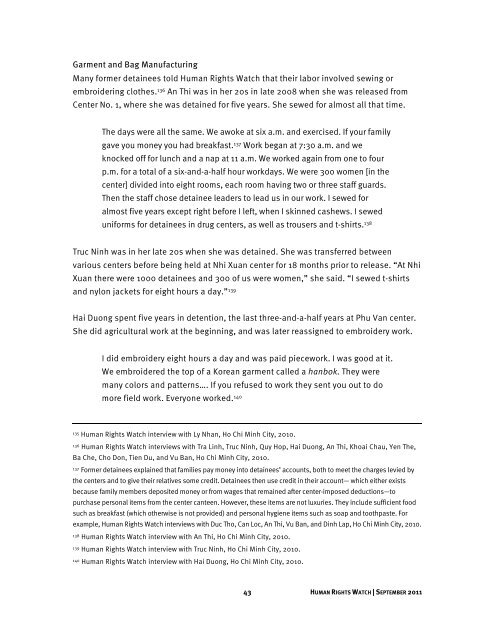The Rehab Archipelago - Human Rights Watch
The Rehab Archipelago - Human Rights Watch
The Rehab Archipelago - Human Rights Watch
You also want an ePaper? Increase the reach of your titles
YUMPU automatically turns print PDFs into web optimized ePapers that Google loves.
Garment and Bag Manufacturing<br />
Many former detainees told <strong>Human</strong> <strong>Rights</strong> <strong>Watch</strong> that their labor involved sewing or<br />
embroidering clothes. 136 An Thi was in her 20s in late 2008 when she was released from<br />
Center No. 1, where she was detained for five years. She sewed for almost all that time.<br />
<strong>The</strong> days were all the same. We awoke at six a.m. and exercised. If your family<br />
gave you money you had breakfast. 137 Work began at 7:30 a.m. and we<br />
knocked off for lunch and a nap at 11 a.m. We worked again from one to four<br />
p.m. for a total of a six-and-a-half hour workdays. We were 300 women [in the<br />
center] divided into eight rooms, each room having two or three staff guards.<br />
<strong>The</strong>n the staff chose detainee leaders to lead us in our work. I sewed for<br />
almost five years except right before I left, when I skinned cashews. I sewed<br />
uniforms for detainees in drug centers, as well as trousers and t-shirts. 138<br />
Truc Ninh was in her late 20s when she was detained. She was transferred between<br />
various centers before being held at Nhi Xuan center for 18 months prior to release. “At Nhi<br />
Xuan there were 1000 detainees and 300 of us were women,” she said. “I sewed t-shirts<br />
and nylon jackets for eight hours a day.” 139<br />
Hai Duong spent five years in detention, the last three-and-a-half years at Phu Van center.<br />
She did agricultural work at the beginning, and was later reassigned to embroidery work.<br />
I did embroidery eight hours a day and was paid piecework. I was good at it.<br />
We embroidered the top of a Korean garment called a hanbok. <strong>The</strong>y were<br />
many colors and patterns…. If you refused to work they sent you out to do<br />
more field work. Everyone worked. 140<br />
135 <strong>Human</strong> <strong>Rights</strong> <strong>Watch</strong> interview with Ly Nhan, Ho Chi Minh City, 2010.<br />
136 <strong>Human</strong> <strong>Rights</strong> <strong>Watch</strong> interviews with Tra Linh, Truc Ninh, Quy Hop, Hai Duong, An Thi, Khoai Chau, Yen <strong>The</strong>,<br />
Ba Che, Cho Don, Tien Du, and Vu Ban, Ho Chi Minh City, 2010.<br />
137 Former detainees explained that families pay money into detainees’ accounts, both to meet the charges levied by<br />
the centers and to give their relatives some credit. Detainees then use credit in their account— which either exists<br />
because family members deposited money or from wages that remained after center-imposed deductions—to<br />
purchase personal items from the center canteen. However, these items are not luxuries. <strong>The</strong>y include sufficient food<br />
such as breakfast (which otherwise is not provided) and personal hygiene items such as soap and toothpaste. For<br />
example, <strong>Human</strong> <strong>Rights</strong> <strong>Watch</strong> interviews with Duc Tho, Can Loc, An Thi, Vu Ban, and Dinh Lap, Ho Chi Minh City, 2010.<br />
138 <strong>Human</strong> <strong>Rights</strong> <strong>Watch</strong> interview with An Thi, Ho Chi Minh City, 2010.<br />
139 <strong>Human</strong> <strong>Rights</strong> <strong>Watch</strong> interview with Truc Ninh, Ho Chi Minh City, 2010.<br />
140 <strong>Human</strong> <strong>Rights</strong> <strong>Watch</strong> interview with Hai Duong, Ho Chi Minh City, 2010.<br />
43 HUMAN RIGHTS WATCH | SEPTEMBER 2011

















